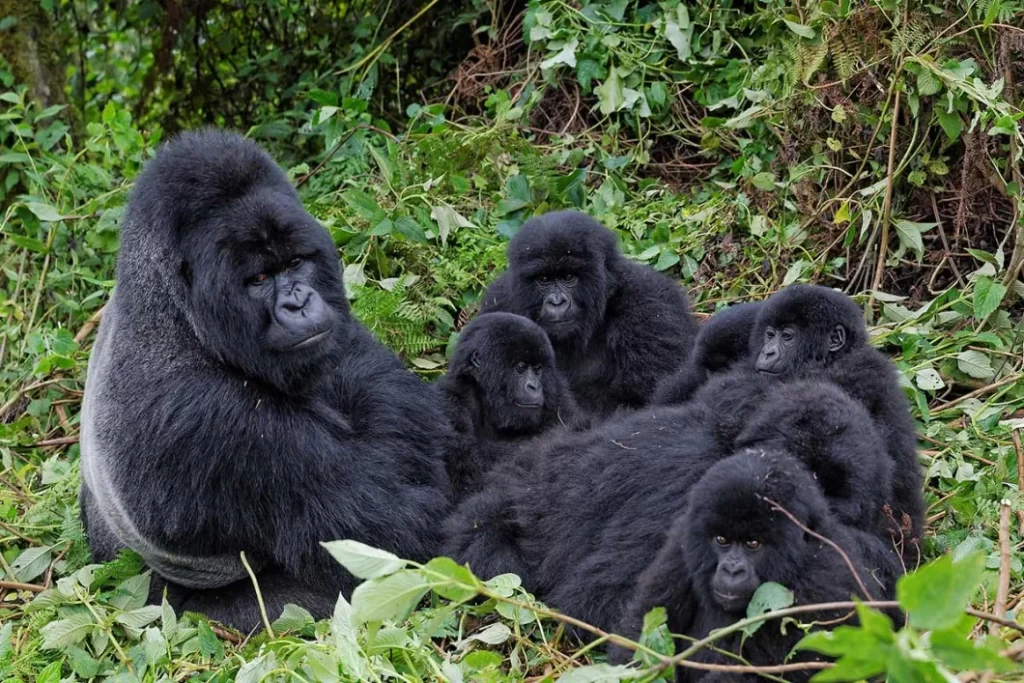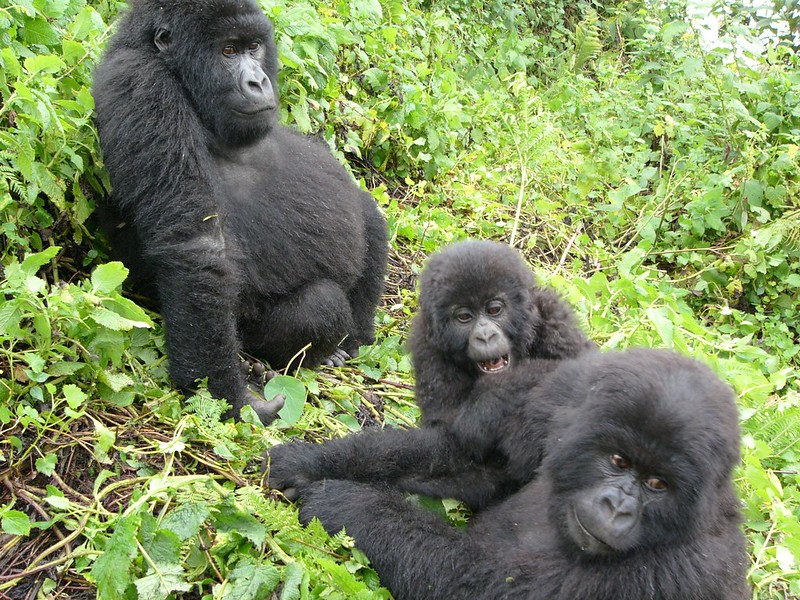Face To Face With Gorillas In Africa
Face To Face With Gorillas In Africa , I am precariously positioned atop a resilient mass of dense underbrush while a swarm of mosquitoes hovers eagerly. The elusive mountain gorilla that my crew has been monitoring descends the slope with agility and halts directly in front of me. Leaning idly against a tree trunk, his deep brown eyes, both compassionate and intellectual, fixate unblinkingly on me. I never anticipated engaging in a staring contest with a mountain gorilla.
This journey commenced in Kigali, the beautifully preserved capital of Rwanda. Upon arrival, my guide, Andrew, a patient individual with extensive knowledge of the area animals, greeted me with a vintage Land Rover, which would serve as my transportation for the ensuing days. As we traveled rhythmically, the scenery shifted from the metropolitan expanse of modest residences to boundless undulating greenery. I reciprocated the gesture to the enthusiastic young children clustered on the dusty sides, adorned with broad smiles and inquisitive gazes.

I was en route to Virunga Lodge, one of four opulent camps comprising Gorilla Trekking in Africa . Established two decades ago by conservationist and entrepreneur Praveen Moman, the company pioneered gorilla tourism in these delicate post-conflict areas. The objective was to advance conservation and enhance the welfare of local populations through employment opportunities and community-oriented initiatives. In addition to desiring to observe the mountain gorilla in its natural environment, I was eager to assess the outcomes of Moman’s endeavors.
I relaxed in my seat, the invigorating scent of fresh rain permeating through the open windows, and proceeded on my journey northward. The winding road had contracted into a narrow dirt path that meandered along the brink of a cliff. The profound valley underneath was eclipsed by the opposing mountain, its summit aglow with the late afternoon sun emerging from the dissipating clouds.
Situated on a ridge, Virunga Lodge features ten bandas, or bungalows, each offering a picturesque view of either the imposing Virunga volcanoes or the lovely Bulera and Ruhondo lakes. Their lustrous surfaces mirrored the rainbow that materialized, seemingly by enchantment, upon my arrival.
Subsequently, while enjoying a hot goat stew in the main home, I conversed with Moman. Originating from Uganda, where his family belonged to the early Asian population that first settled in the country under British governance, he relocated to the UK as a refugee during the Amin deportation. In the early 1990s, he returned to his homeland, motivated by a partially romanticized vision rooted in boyhood recollections, to establish the safari enterprise.
I inquired of Moman how gorilla conservation supports the livelihoods of local inhabitants, and his eyes brightened. “In my view, it is rather straightforward.” He stated that meticulously regulated tourism is crucial for the conservation of gorillas. “Conservation initiatives alone are insufficient, particularly in African nations rich in oil and minerals. However, leveraging tourism to engage local communities generates income and sustains their livelihoods.” In the absence of that, you will receive no assistance for conservation efforts. Consequently, all Volcanoes Safaris lodges are maintained by local personnel and each has its own community projects, which encompass basic educational dance groups and vocational initiatives designed to empower locals for sustainable livelihoods.
The following morning, eager for my gorilla encounter, I awoke before to my 5 AM alarm and hastily emerged from beneath my mosquito net in the darkness. Upon exiting my room, the air was cool and rather humid against my skin, while the horizon began to emit a misty pink hue. A gentle luminescence enveloped the terrain, establishing an ethereal ambiance for my expedition to Volcanoes National Park, the habitat of the mountain gorillas.
Situated in the northwestern region of Rwanda, the park encompasses a 60 square-mile area of dense rainforest and dense bamboo, forming part of a broader network of thick jungle that extends westward into the Democratic Republic of Congo and northward into Uganda. This location houses fifty percent of the gorilla population, while the remainder resides in the dense Bwindi Impenetrable Forest in southwestern Uganda. The Rwandan region has the habitat of 30 gorilla families. Ten are monitored for tourism purposes, while the remainder is utilized for research. Daily, eight individuals are permitted to spend a brief hour with a family, and the duration of your journey will invariably rely on the gorillas’ whereabouts.
The Isabukuru family was located less than two miles distant; nevertheless, upon entering the rainforest, it became evident that accessing them would need considerable time. The trees were tall and closely clustered. Certain trees possessed old trunks intertwined into formidable sinews that extended into a terrain so saturated that traversing it became arduous. Following an extended period of laboriously ascending through viscous mud, our convoy decelerated. The group’s conversation diminished to a whisper, rendering the silence complete. Beck, our guide, gestured for us to follow, navigating through the trees to a clearing. Uncertain of what was ahead, I scanned my surroundings anxiously until I noticed a flash of black fur in a thicket of shrubs, and a gorilla, with an infant in tow, emerged and positioned itself a few meters before me. Although not the largest in her species, her formidable size was nonetheless intimidating. I observed her fingers, remarkably similar to ours, skillfully shred bamboo leaves from a tree, while attentively monitoring her curious toddler. “Infant gorillas resemble our human children,” murmured Beck, who stood next me. “They exhibit curiosity and will attempt to make physical contact with you.” It is acceptable for them to remain still and refrain from reciprocating any physical contact.
Before I could contemplate this notion, the bushes began to rustle once more, and in an instant, the entire family emerged before me, with juveniles swinging from branches overhead, others leisurely consuming bamboo leaves, while the robust silverback, the dominant male of the group, ambled over and nonchalantly settled into a heap of foliage, scratching his abdomen as he yawned. These gorillas are not domesticated; rather, they are habituated to humans, allowing us to view them freely as they engaged in their activities. As I observed in silence, I contemplated Moman’s remarks from the previous night. Could my presence there, as a visitor, genuinely be contributing to the survival of the gorillas?
The evidence appears to indicate that this is accurate. Moman’s initiative has substantially augmented the gorilla population from approximately 620 in the early 1990s, when conservation efforts commenced, to roughly 880 presently. This has also established the foundation of Rwanda’s burgeoning tourism sector. The introduction of the premium hotel brand One & Only, alongside the government’s contentious decision to double the price of gorilla licenses to USD $1,500 overnight, exemplifies this situation. The initial reaction to the fee increase was one of fury; however, Moman clarified, “With fewer than 100 permits issued daily, gorilla tourism must be considered a high-value product.” I do not oppose the increase in price, as I consistently assert that tourism is vital for gorilla conservation; nonetheless, the implementation has not been executed in the most suitable manner.
Before long, the golden hour concluded, and I commenced my perilous plunge. After a few hours, content and soiled, I reentered the Land Rover and commenced my journey to Uganda, eagerly awaiting my forthcoming gorilla encounter in the Bwindi Impenetrable Forest.

Early the following morning, while consuming porridge and fresh fruit, I conversed with Joselyne, the manager of Bwindi Lodge, who indicated that my imminent experience in the Impenetrable Forest would differ from the previous one. “The forest is named for a specific reason,” she chuckled. Indeed, I quickly discovered the 128 square-mile UNESCO World Heritage site to be as inflexible as its designation implies. The dense jungle foliage was traversable alone with the assistance of machete-bearing guides, who skillfully cleared the thick underbrush and entangled vines. This provided but a fleeting glimpse of the gorillas as they navigated the underbrush, appearing and disappearing from sight. This encounter starkly contrasted with my experience in Volcanoes National Park, underscoring the reality that, despite their habituation, gorillas are still wild and elusive beings. This remains their homeland, and I am merely a tourist, privileged to have received an invitation.
The following day, while journeying north through Uganda, adjacent to the Democratic Republic of the Congo, I was captivated by the land’s uniqueness, as the verdant highlands seamlessly transitioned into the arid, grassy plains of Queen Elizabeth National Park. The atmosphere was arid and sweltering as we navigated the deteriorating roads, avoiding substantial potholes and encountering herds of elephants fanning their ears. Adhering and gritty, we decelerated at the eastern perimeter of the park, where the landscape had shifted to unveil the profound chasm of the Kyambura Gorge. This tropical ravine housed a family of chimpanzees, whose frenetic, violent shrieks reverberated below. As the setting sun transformed the sky into a brilliant orange that gradually faded into wisps of pink and purple, I reflected on all that I had observed in the preceding days. Mountain gorillas would likely have faced extinction without the efforts of pioneering conservationists such as Moman. The evidence, for these susceptible beings, is in their joyfully increasing population. In the absence of tourists, gorillas would not exist.
